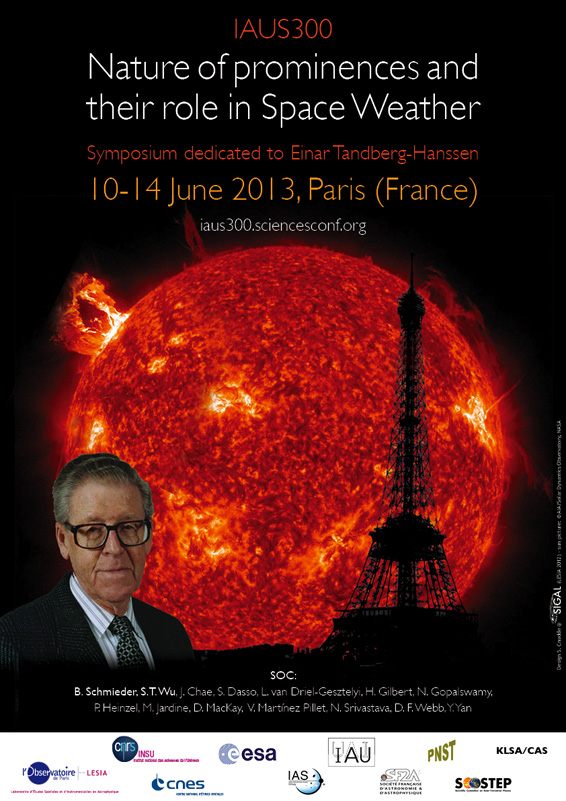
|
|
|
Main menu
HELP
|
Home page IAUS300, Nature of Prominences and their role in Space WeatherIAUS300 is the 300th symposium organized under the patronage of the International Astronomical Union / Union Astronomique Internationale (website). Einar Tandberg-HanssenIAUS300 is dedicated to the memory of Professor Einar Tandberg-Hanssen who passed away in July 2011. He was deeply involved in prominences studies until the end of his life (see his last paper in Solar Physics February 2011). He is the author of the book “The nature of solar prominences”, published in 1995 and which is taken as the authority in the field.
Program Participants can directly download the pdf file of the IAUS Program. Payment The fees (350 Euros) include acces to the conference venue, 3 lunches, the conference dinner and the proceedings book. To proceed with the payment please follow the procedure detailed on the payment webpage. The secure website requests first that participants fills some information. Before being able to proceed with payment, participants must wait to receive an email of confirmation (which can take up to several days). Credit cards are accepted. Participants paid by French laboratories must pay via order ("Bon de Commande"). The deadline for payment was April 27th 2013.
Financial support and visas Some grants were available, mainly for young researchers. The deadline to request financial support was January 15th 2013. All the available grants have now been allocated. Participants who need a visa for France should contact the symposium organizers as early as possible: iaus300@sciencesconf.org RationaleThe aim of this IAU Symposium is to present a review of the state-of-the-art of the theoretical, numerical modeling, and space-borne and ground-based observational studies of prominences and their role in the dynamics of Sun-Earth relations. It also aims at opening new perspectives for the people, and especially young ones, working in the field. Prominences have an active role in the Space Weather. Magnetic clouds and the Coronal Mass Ejections (CME) associated to erupting prominences can produce severe perturbations in GPS, in telecommunications and for satellites and space inhabited vessels. So it is time to put together the many efforts made to understand their physics in order to be able to make forecasts about their possible impact on our space environment. Moreover, huge prominences and CME have been detected in solar-type stars (and others) and it is interesting to put the properties of solar prominences in a broader perspective, on one hand, and to present the status of the sophisticated solar analysis to the concerned stellar community on the other hand. In summary, we would like to bring together different communities in astrophysics. Key topics1/ Prominences: dynamics, fine structure, seismology Aulanier G., Ballester J.L., Berger T., van Ballegooijen A., Carlsson M., Dal Lago A., Démoulin P., Gibson S., Gunar S., Green L., Hasan S., Hussain G., Karpen J., Kodachenko M., Labrosse N., Lavraud B., Lee T., Lepri S., Lites B., Lopez-Ariste A., Lugaz N., Martens P., Parenti S., Priest E., Rimmele T., Shibata T., Thompson W., Valori G., Vidotto A., Wimmer-Schweingruber R., Zhong L.
|
| Online user: 1 | RSS Feed |

|



